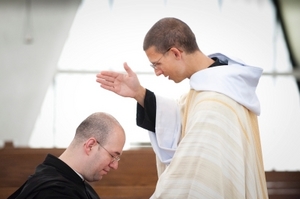
Preaching the first Mass of a newly ordained member of his monastic community, Benedictine Father Ambrose Bennett cited "Emmanuel Cardinal Suhard, who served as Archbishop of Paris in the post-war years, expressed this mystery [of the priesthood] very eloquently in a beautiful pastoral letter that he wrote to his priest on Holy Thursday of 1949:
At the altar, the priest, like Christ, is the [sacrificial] victim. But he is also the sacrificer; he is then the dreadful man, the one who works death, the one who slays sin and burns it, the one who is crucified and who crucifies, the one who cannot save the world, nor will consent to its salvation, save through nailing it to the Cross. "Without the shedding of blood there is no redemption" (Heb. 9.22)... That is why the priest in relation to society must always be somehow or other its adversary. He will never be forgiven for recalling and perpetuating, from generation to generation, Christ, whom they thought they had suppressed forever... Far from being a fatherly adviser or a good-natured citizen, a priest is, like God, a terrible being. He is a fighting man... Like Saint Michael, he challenges the Dragon, dragging him out of ambush by healing men's hearts, so as to crush one by one his ever resurgent heads. Although it is too frequently overlooked, a priest is an exorcist...; he has the power and the duty of expelling the Devil (Cardinal Suhard, Priests Among Men, pp. 82-83; 44-45).

